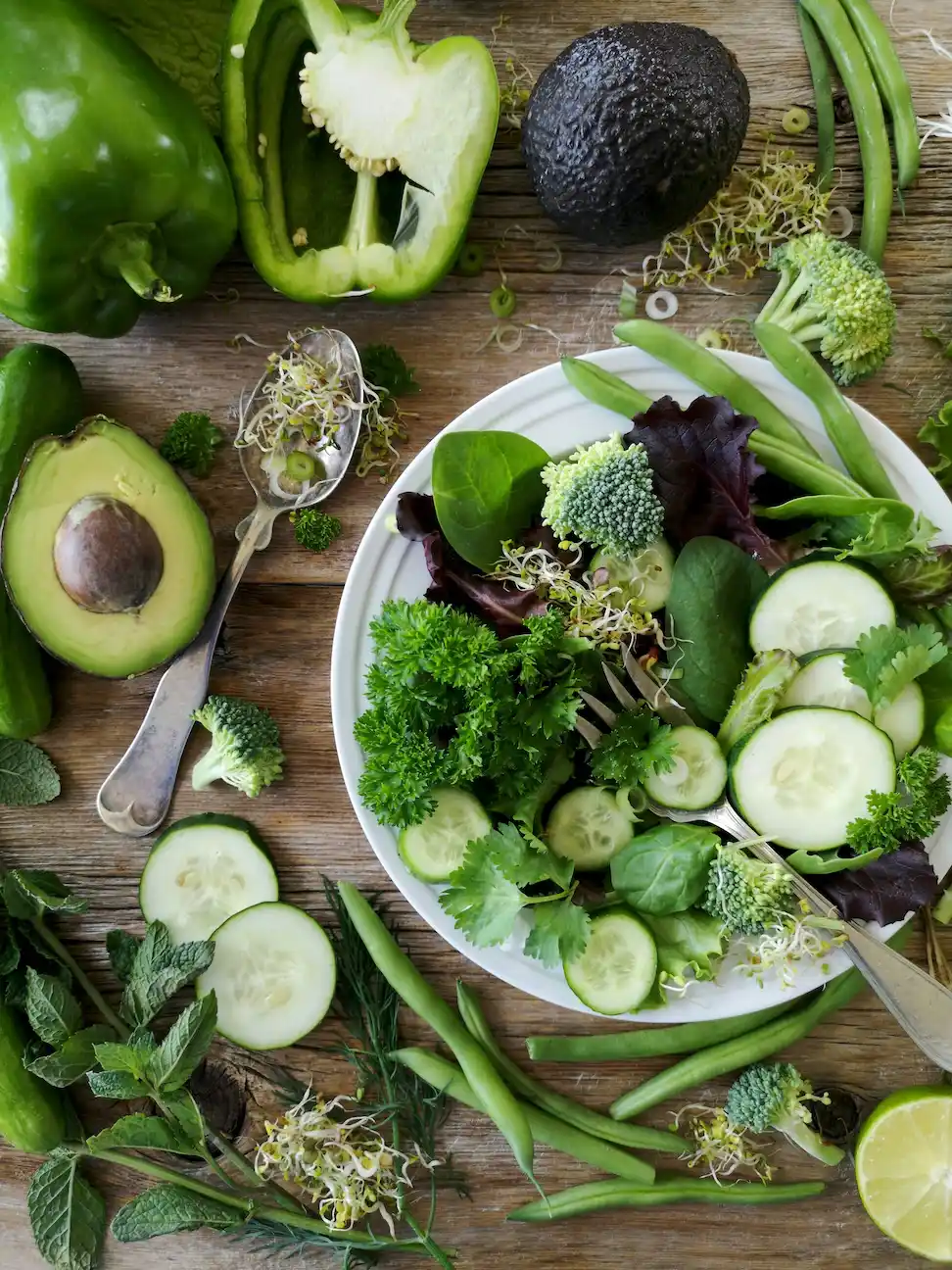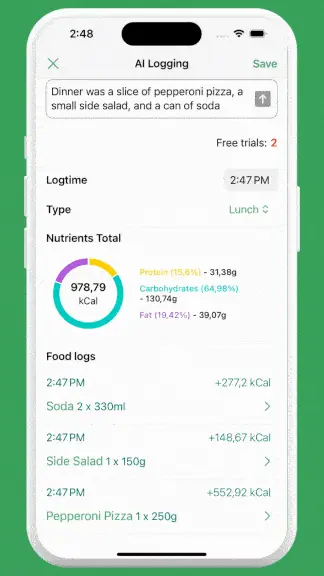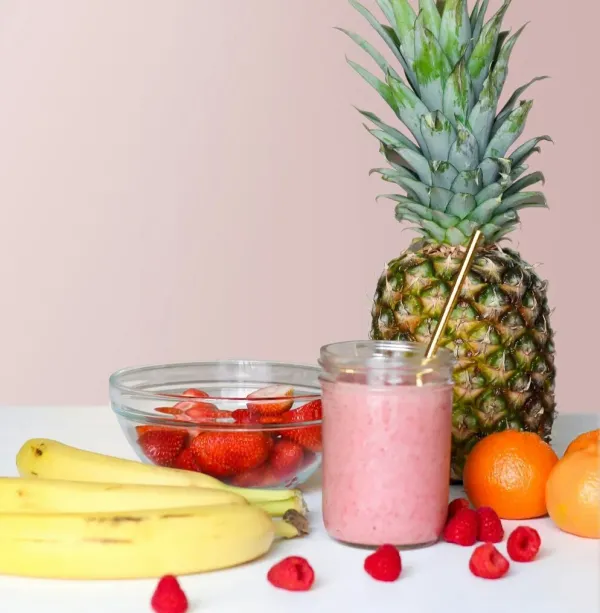Easily Calculate Calories in Salad for Healthy Meal Planning

Wondering how to calculate calories in salad? You’re not alone. Whether you’re dieting or just health-conscious, getting a grip on the caloric content of your salads is essential. This article will guide you through identifying the calorie counts of various salad ingredients, from leafy greens to dressings, and provide you with practical tools to pinpoint the total calories of any salad you assemble. Let’s dive in and make calorie counting as straightforward as mixing your favorite greens.
Key Takeaways
- Understanding and calculating salad calories is vital for informed dietary decisions and healthier meal planning, especially considering the varying calorie counts of different salad components such as toppings and dressings.
- A nutritious salad should balance different ingredients including a variety of greens, protein sources, flavorful toppings, and dressings, each contributing to the meal’s overall taste, texture, and nutritional value.
- The FoodIntake app simplifies calorie counting by allowing users to input ingredient measurements for instant salad calorie calculations, encouraging correct portion sizes, and supporting overall health management.
Why Calculating Salad Calories Matters
Assessing the caloric value of your salad goes beyond mere numbers; it serves as a cornerstone for healthier meal planning. With a salad calories calculator at your fingertips, you can make informed dietary decisions tailored to your specific objectives, be it muscle building, weight management, or achieving a balanced diet. But with the vast array of possible salad ingredients - think fruits, veggies, mixed greens, proteins, dressings, and various toppings - accurately estimating the calorie content without a proper tool can be a daunting task.
However, it’s not just about knowing how many calories are in your salad; understanding the caloric value of your meal can help you avoid common pitfalls related to portion sizes and underestimation of calorie intake. We’ll further explore this issue.
Benefits of Tracking Calorie Intake
When it comes to maintaining or losing weight, knowledge is power. Mastering the calculation of salad calories can deter calorie intake underestimation and assist in maintaining your diet. Ever wondered how a small soda or an extra serving of your favorite entrée can impact your calorie intake? Over time, larger food portions can lead to consistent increases in energy intake, potentially contributing to weight gain.
Even portion sizes in restaurants, which are often larger than necessary, may contribute to increased energy intake as many of us tend to finish our served entrées.
Common Misconceptions About Salad Calories
It’s a common misconception that all salads are naturally low in calories. But the reality is, different salad ingredients can have unreported calories, leading to an underestimation of the total calories in your salad.
A prime example is the traditional Caesar salad. Often perceived as a light meal, a Caesar salad can actually contain up to 450 calories, demonstrating that salads can be higher in calories than often thought.
Key Components of a Nutritious Salad
A well-balanced salad is much more than just a bowl of lettuce. It’s a symphony of ingredients that come together in a harmonious blend of flavors, textures, and nutritional values. In essence, four main categories of ingredients shape this nutritional canvas:
- Lettuce
- Toppings
- Proteins
- Dressings
Each ingredient has its unique role in the salad mix, providing a different layer of taste and nutrients. The lettuce category, for instance, includes greens like:
- arugula
- baby spinach
- butter lettuce
- kale
- romaine hearts
These greens form the nutritious base of the salad. We’ll further investigate these components to gain a better understanding of their contributions to a nutritious salad.

Greens: The Foundation of a Healthy Salad
The beauty of salads lies in their versatility. With a variety of greens like:
- arugula
- baby spinach
- butter lettuce
- kale
- romaine hearts
at your disposal, you can create a salad that caters to your taste buds while boosting your nutrient intake. Romaine hearts, for instance, provide a crisp texture and are valued in salad mixes for their high nutritional content.
Arugula adds a unique peppery flavour to salads and is chosen for its numerous nutritional benefits. On the other hand, kale is recognized as a nutrient-dense green, offering substantial vitamins and minerals in salads, while baby spinach is favoured for its tender texture and high vitamin content.
Protein Sources: Adding Satiety and Nutrition

Besides adding a hearty bite to your salad, proteins can significantly increase the satiety and nutritional value of your meal. Whether you’re a meat lover or a vegetarian, the options are aplenty. Animal-based proteins such as grilled achiote chicken, grilled chicken, and grilled flat iron steak can be your go-to proteins.
For those following a plant-based diet, house-baked falafel crumbles and marinated organic tofu are excellent choices.
Toppings: Enhancing Flavor and Nutrient Content

The real magic of salads lies in the toppings. From fruits to vegetables, nuts, and legumes - they not only enhance the flavor but also boost the nutrient content of your salad. Some delicious toppings to consider are:
- Raw vegetables like carrots and cucumbers
- Toasted nuts such as almonds and walnuts
- Legumes like chickpeas and lentils
- Cooked vegetables like roasted cauliflower or caramelized onions
Adding these toppings, such as red onions and sunflower seeds, can add a different dimension to your salad and make it even more delicious and nutritious.
Pairing toppings like strawberries and almonds with a minimal amount of dressing can create a salad that’s both delectable and low in calories, giving your taste buds a significant flavor boost.
Dressings: Balancing Taste and Calories

A dressing can make or break your salad. It not only adds flavor but also significantly impacts the overall calorie content of your salad. Here are some options to consider:
- Creamy dressings like Caesar can increase the calorie count.
- Options like lemon herb vinaigrette and balsamic vinegar tend to be lighter.
- Using ingredients such as nonfat Greek yogurt in salad dressings can enhance protein levels while keeping calories in check compared to traditional dressings.
If you’re feeling adventurous, why not whip up a homemade balsamic vinaigrette dressing? Here’s a recipe for a delicious and healthy dressing:
- 2 tablespoons balsamic vinegar
- 1 tablespoon light soy sauce
- 1 teaspoon Dijon mustard
- 1 teaspoon honey
- 2 tablespoons Greek yogurt
- 2 tablespoons olive oil
Simply mix all the ingredients together and drizzle over your favorite salad. This homemade dressing offers a balance of flavors while keeping calories low compared to many store-bought dressings. Enjoy!
How to Calculate Salad Calories with FoodIntake app: A Step-by-Step Guide
Given the multitude of ingredients and factors to consider, the task of calculating salad calories can be complex. But with the FoodIntake Salad Calories Calculator, this process is made simple and accurate. This tool allows you to sum the calories of each salad ingredient based on their weight, giving you a clear picture of your total caloric intake.
The use of the Salad Calories Calculator is straightforward. Simply follow these steps:
- Hit ‘Analyze’ to generate an initial list of ingredients.
- After FoodIntake’s AI extracts all foods, you can edit the ingredients.
- Adjust individual ingredients, add new ones, or delete specific ingredients.
- Modify the contribution size of each ingredient in your recipe.
- Adjust the total meal portion size.

Manual Calculation: Using Nutrition Labels and Online Resources
Although manual calculation of salad calories with nutrition labels and online resources is feasible, it can be time-consuming and susceptible to errors. Not only does it consume more time compared to automated solutions, but it may also miss some data, forcing you to use multiple tools for better results.
FoodIntake Mobile App: Convenient Calorie Counting
The FoodIntake mobile app offers the following features:
- Extensive food database
- Barcode scanning
- Exercise tracking
- Nutrient intake tracking
- Meal calorie calculation
It is a comprehensive tool for managing your overall health.
The app’s user-friendly interface and comprehensive weight loss features make calorie counting a breeze. What’s more, it supports overall health management by allowing integration with other health tools and devices.
FoodIntake Salad Calories Calculator: Quick and Accurate Results
The FoodIntake Salad Calories Calculator is a tool designed to provide accurate calorie counts for each salad ingredient. It offers instant calculations, a comprehensive food database, and functionalities for tracking daily food intake, making it a user-friendly option for managing caloric consumption.
These calculators assist in putting together tailor-made salad recipes that adhere to personal health objectives and dietary restrictions. What’s more, the FoodIntake salad calorie calculator can be effectively paired with a daily calorie intake calculator, supporting users in achieving their dietary goals related to weight management. Additionally, a nutrition calculator can help users make informed choices about their salad ingredients.

Tips for Creating Lower-Calorie Salads
Creating a flavorful, low-calorie salad doesn’t have to be a daunting task. With a variety of fresh ingredients at your disposal, you can whip up a tasty salad that’s low in calories.
For instance, using Greek yogurt in salad dressings can add creaminess while keeping calorie counts low compared to traditional creamy dressings.
Choosing Nutrient-Dense Ingredients
Selecting nutrient-rich ingredients for your salad is a vital step towards healthy meal planning. Fresh garden vegetables and herbs are examples of ingredients that can increase the nutritional content of a salad without contributing excessive calories. By incorporating these low-calorie, nutrient-dense ingredients, you can create a more nutritious salad that supports health without compromising on your caloric goals.
Portion Control: Avoiding Excess Calories
While the ingredients make up the salad, portion sizes determine the caloric value. The nutritional value of a salad can be significantly influenced by the selection of salad toppings and the control of portion sizes. By understanding the nutritional information of each ingredient, one can make healthier choices.
Pre-measured single servings of salads, such as in a jar, can help control portion size and manage calorie intake.
Experimenting with Homemade Dressings

Lastly, trying out homemade dressings can revolutionize the creation of low-calorie salads. Preparing homemade dressings with fresh herbs and minimal ingredients can reduce the calorie content of salads.
For instance, a homemade dressing with sesame oil, garlic, ginger, and citrus juices, including lemon juice, offers a potent taste while maintaining low carb content.
Summary
In summary, knowing the caloric value of your salad is crucial for healthy meal planning and weight management. From selecting nutrient-dense ingredients to practicing portion control and using the FoodIntake Salad Calories Calculator, you can take control of your salad calorie count. So, why not start exploring the world of salads, armed with the knowledge of their caloric content and the ability to make healthier choices?
Frequently Asked Questions
How to calculate the calories of a salad?
To calculate the calories of a salad, make a list of the ingredients and their respective calorific values per serving, then sum up the calories of each ingredient to find the total calorie count for the salad.
Should I count the calories of salad?
Yes, you should count the calories of salad as they contribute to your daily intake and are not "negative calorie" foods. Be mindful of your salad portion and dressing choices when monitoring your calorie intake.
Can the FoodIntake Salad Calories Calculator also calculate the caloric value of homemade dressings?
Yes, the FoodIntake Salad Calories Calculator can calculate the calorie count of homemade dressings based on the ingredients and their quantities.
Are all salads low in calories?
Not all salads are low in calories because the calorie content of a salad depends on its ingredients and their quantities. It's important to be mindful of the ingredients used when choosing a salad to ensure it aligns with your dietary goals.
Is it possible to create a low-calorie salad that's also tasty?
Yes, it is possible to create a delicious low-calorie salad by using nutrient-dense ingredients and experimenting with homemade dressings. Enjoy!
See another examples of calculating calories for recipes or meals:








